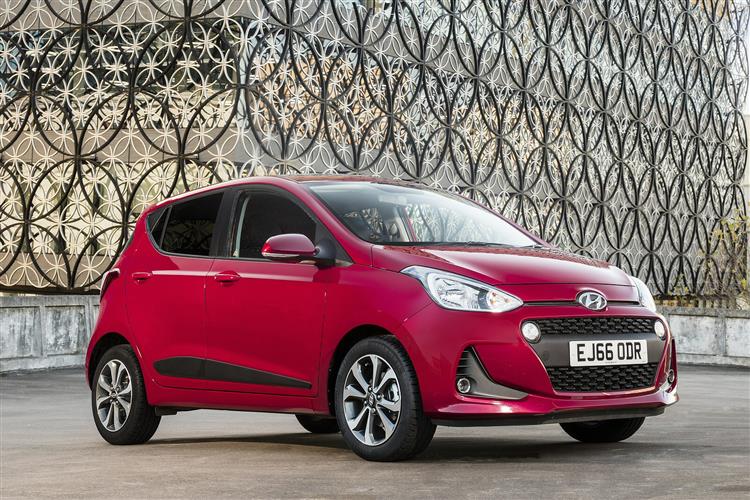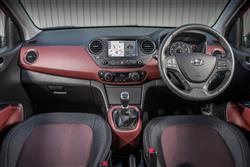CITY SLICKER (some text hidden) --NONE--
By Jonathan Crouch
Introductionword count: 140
Hyundai doesn't make all that many models that can be considered potentially class-leading but the i10 city car has always fitted that description, especially in the second generation form that was launched in 2013. If you're looking at one of these on the used market, we'd suggest that it might be worth stretching to the facelifted version of this MK2 design, launched at the end of 2016 and profiled here from a previously owned perspective. This improved second generation contender introduced a level of infotainment connectivity and electronic safety provision that buyers in this class hadn't previously seen. As before though, its main draw lay with spacious practicality and in the way it did the basic city car things really, really well. There may be more exciting urban runabouts than this on your radar, but there aren't many better ones.
Modelsword count: 15
5dr citycar (1.0 66PS petrol / 1.2 87PS petrol - S, SE, Premium, Premium SE)
Historyword count: 415
This model, the Hyundai i10, has long been one of this country's very best-selling city cars. This Korean contender achieved that distinction in its original guise by being very cheap. This second generation design though, consolidated its predecessor's position very much on merit. Here, we're going to look at the facelifted version. One of the interesting things about the market's smallest segment is that it's one of the very few in which you can expect the sales leader to also be the best car. Buyers in search of an urban runabout, you see, can't be bothered with the snobby image issues that restrict Hyundai sales in larger market categories. Which means that the Korean brand has always had a real opportunity for sales growth when it comes to vehicles like this - one that the company has grabbed with both hands in the last few decades. True, its early city car efforts - the curiously quirky Atoz of 1998 and the 'Postman Pat'-like Amica that almost immediately replaced it - were better suited to Far Eastern tastes than European ones. By 2008 though, Hyundai was getting the hang of what Western families were looking for. That was the year we first saw the MK1 model version of this i10, a car that offered supermini style in a smaller, cheaper, more agile and more versatile package than anything we'd seen before. Sales took off, boosted in the UK by the government Scrappage scheme, and across Europe, nearly half a million i10s quickly found happy homes. This smarter, more sophisticated second generation model, launched in 2013, continued this strong showing, but by the end of 2016 faced much tougher opposition from a much wider range of better prepared adversaries. Volume brands like Ford and Vauxhall were by then much stronger players in this segment than they had previously been. Hence the need for this much improved MK2 model i10, announced in the Autumn of 2016. As a segment leader, it needed to be a standard-setter, hence the availability of 'big car' features like a touchscreen navigation system, 'Apple CarPlay' and 'Android Auto' 'phone connectivity and camera-based safety systems that deliver things like autonomous braking and Lane Departure Warning technology. In addition, as before, buyers got one of the most spacious contenders in the class and the potential for running cost efficiency that bettered most major rivals. In this form, the i10 sold until the end of 2019, when it was replaced by an all-new third generation design.
What You Getword count: 233
The main styling changes made to the updated version of this MK2 i10 can be seen at the front, which adopted the more distinctive 'Cascading grille' that by 2017 was characterising several of Hyundai's models. Upper-spec versions got small, circular LED daytime running lights in the grille's outer corners and even smaller front fog lamps built into more sharply-defined lower corner air intakes. Back in 2013 when the second generation i10 model was originally launched, the interior of this model set fresh standards for city car quality and design and even by 2017, it was still one of the nicer cabins in this segment. For this facelifted model, the ambience could be lifted with optional blue or red trimming for the dashboard and the upholstery. Plus, on the top 'Premium SE' variant, the fascia gained a more sophisticated feel thanks to the addition of a 7-inch touchscreen Navigation system. In the rear, you'll find a decent level of roominess for this class of car, providing you stick with the carriage of just a couple of adults. Even with a couple of six-footers installed in the back, front seat occupants shouldn't have to compromise space to accommodate them. And the boot? Well the tailgate rises to reveal one of the largest trunk openings in the segment and a 252-litre total boot capacity that's one of the very biggest in the class from this period.
To see the full road test text contact us on 0330 0020 227
Pictures (high res disabled)

.jpg)
|
.jpg)
|
.jpg)
| |||
.jpg)
|
.jpg)
|
.jpg)
| |||
.jpg)
|

|
Scoring (subset of scores)
Category: Small Runabouts
| Performance | |
| Handling | |
| Comfort | |
| Space | |
| Styling, Build, Value, Equipment, Depreciation, Handling, Insurance and Total scores are available with our full data feed. | |



